
29
5.2 START
Please review the engine controls section and the engine owners manual for starting and stopping the
engine.
5.2.1 STARTING THE GENERATOR:
•
Ensure the main power switch / breaker is
in the "off" position or turn all the appliances
or electrical loads off.
•
Plug in power cords from appliances or
loads.
•
Ensure the cooling vents around the
alternator are free and not blocked
•
Pull start
: Turn on the ignition switch, pull
sharply on the starting rope T bar to
start the
engine. (Refer to engine manual for detailed
engine starting procedure.)
Electric start:
Turn ignition switch located
on control panel to start the engine. Release
the switch once engine starts.
•
Run the engine for a few moments until it
warms up.
•
Flip the main switch / breaker to "on", or
switch appliances or electrical loads on.
5.2.2 STOPPING:
•
Flip the main power switch / breaker to the
"off" position or turn all the appliances or
electrical loads off.
•
Run the engine for a few moments to allow
the engine to cool.
•
Switch engine off, unplug all appliances or
loads.
5.2.3 EMERGENCY STOPPING:
•
Immediately flip off the main breaker
•
Turn the engine off.
•
Correct the emergency condition before
resuming work and re-starting the engine.
5.2.4 TERRAIN:
The generator works well in a wide variety
of operating conditions but it should always
be positioned on a level surface. When the
frame is level, fuel spillage is minimized and
the gas tank capacity is maximized. Do not
operate unless the frame is level.
5.2.5 WEATHER:
•
Do not operate in the rain, in damp wet
conditions or with wet hands. Keep the
generator and work area dry to prevent
shocks and shorts. Use properly rated,
grounded 3-prong extension cords, tools,
and appliances.
•
Do not operate at temperatures above
100° F (40° C) to prevent overheating of the
engine or generator. Always run for a few
minutes without an electrical load to help
cool the components before shutdown.
5.2.6 ELECTRICAL LOADS:
The generator is ideally suited to camping,
farm, household, workshop, construction site
or anywhere that back-up power is required.
In order to determine the power requirements
of your appliance, refer to section 4.6.
If the power draw for the appliance exceeds
the outlet capacity,
the circuit breaker will be
tripped
. Reduce the current draw and reset
the breaker before resuming operation.
5.2.7 COMPONENT CONDITION:
Always use electrical components that are
in good condition. Do not use electrical
cords, plugs and connectors that are frayed,
damaged, cracked or not in good condition.
Electrical components that are not in good
condition can lead to shocks, shorts or
sparking. Any of these conditions can create
and lead to an undesirable or unsafe situation.
5.2.8 ELECTRICAL HAZARDS:
The generator is designed to generate an
electrical current at a high enough power level
to get meaningful work done. However, power
at these levels also includes the possibility of
electrical hazards. Some things to remember
about electrical hazards include but are not
limited to:
•
Keep all electrical components in good
condition.
•
Do not operate with frayed, cracked or
damaged parts.
•
Do not operate if operating in damp or wet
conditions.
•
Do not operate with wet hands.
Summary of Contents for WHS12000
Page 41: ...41...













































